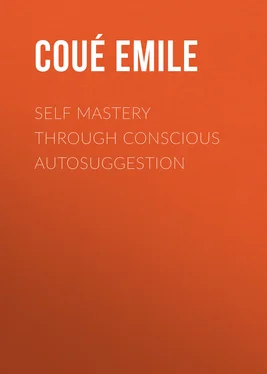Emile Coué - Self Mastery Through Conscious Autosuggestion
Здесь есть возможность читать онлайн «Emile Coué - Self Mastery Through Conscious Autosuggestion» — ознакомительный отрывок электронной книги совершенно бесплатно, а после прочтения отрывка купить полную версию. В некоторых случаях можно слушать аудио, скачать через торрент в формате fb2 и присутствует краткое содержание. Жанр: foreign_edu, Медицина, на английском языке. Описание произведения, (предисловие) а так же отзывы посетителей доступны на портале библиотеки ЛибКат.
- Название:Self Mastery Through Conscious Autosuggestion
- Автор:
- Жанр:
- Год:неизвестен
- ISBN:нет данных
- Рейтинг книги:4 / 5. Голосов: 1
-
Избранное:Добавить в избранное
- Отзывы:
-
Ваша оценка:
- 80
- 1
- 2
- 3
- 4
- 5
Self Mastery Through Conscious Autosuggestion: краткое содержание, описание и аннотация
Предлагаем к чтению аннотацию, описание, краткое содержание или предисловие (зависит от того, что написал сам автор книги «Self Mastery Through Conscious Autosuggestion»). Если вы не нашли необходимую информацию о книге — напишите в комментариях, мы постараемся отыскать её.
Self Mastery Through Conscious Autosuggestion — читать онлайн ознакомительный отрывок
Ниже представлен текст книги, разбитый по страницам. Система сохранения места последней прочитанной страницы, позволяет с удобством читать онлайн бесплатно книгу «Self Mastery Through Conscious Autosuggestion», без необходимости каждый раз заново искать на чём Вы остановились. Поставьте закладку, и сможете в любой момент перейти на страницу, на которой закончили чтение.
Интервал:
Закладка:
Neurasthenia, stammering, aversions, kleptomania, certain cases of paralysis, are nothing but the result of unconscious autosuggestion, that is to say the result of the action of the unconscious upon the physical and moral being.
But if our unconscious is the source of many of our ills, it can also bring about the cure of our physical and mental ailments. It can not only repair the ill it has done, but cure real illnesses, so strong is its action upon our organism.
Shut yourself up alone in a room, seat yourself in an armchair, close your eyes to avoid any distraction, and concentrate your mind for a few moments on thinking: "Such and such a thing is going to disappear", or "Such and such a thing is coming to pass."
If you have really made the autosuggestion, that is to say, if your unconscious has assimilated the idea that you have presented to it, you are astonished to see the thing you have thought come to pass. (Note that it is the property of ideas autosuggested to exist within us unrecognized, and we can only know of their existence by the effect they produce.) But above all, and this is an essential point, the will must not be brought into play in practising autosuggestion; for, if it is not in agreement with the imagination, if one thinks: "I will make such and such a thing happen", and the imagination says: "You are willing it, but it is not going to be", not only does one not obtain what one wants, but even exactly the reverse is brought about.
This remark is of capitalimportance, and explains why results are so unsatisfactory when, in treating moral ailments, one strives to re-educate the will. It is the training of the imagination which is necessary, and it is thanks to this shade of difference that my method has often succeeded where others–and those not the least considered–have failed. From the numerous experiments that I have made daily for twenty years, and which I have examined with minute care, I have been able to deduct the following conclusions which I have summed up as laws:
1. When the will and the imagination are antagonistic, it is always the imagination which wins, without any exception .
2. In the conflict between the will and the imagination, the force of the imagination is in direct ratio to the square of the will .
3. When the will and the imagination are in agreement, one does not add to the other, but one is multiplied by the other.
4. The imagination can be directed.
(The expressions "In direct ratio to the square of the will" and "Is multiplied by" are not rigorously exact. They are simply illustrations destined to make my meaning clearer.)
After what has just been said it would seem that nobody ought to be ill. That is quite true. Every illness, whatever it may be, can yield to autosuggestion , daring and unlikely as my statement may seem; I do not say does always yield , but can yield , which is a different thing.
But in order to lead people to practise conscious autosuggestion they must be taught how, just as they are taught to read or write or play the piano.
Autosuggestion is, as I said above, an instrument that we possess at birth, and with which we play unconsciously all our life, as a baby plays with its rattle. It is however a dangerous instrument; it can wound or even kill you if you handle it imprudently and unconsciously. It can on the contrary save your life when you know how to employ it consciously . One can say of it as Aesop said of the tongue: "It is at the same time the best and the worst thing in the world".
I am now going to show you how everyone can profit by the beneficent action of autosuggestion consciously applied. In saying "every one", I exaggerate a little, for there are two classes of persons in whom it is difficult to arouse conscious autosuggestion:
1. The mentally undeveloped who are not capable of understanding what you say to them.
2. Those who are unwilling to understand .
HOW TO TEACH PATIENTS TO MAKE AUTOSUGGESTIONS
The principle of the method may be summed up in these few words: It is impossible to think of two things at once , that is to say that two ideas may be in juxtaposition, but they cannot be superimposed in our mind.
Every thought entirely filling our mind becomes true for us and tends to transform itself into action .
Thus if you can make a sick person think that her trouble is getting better, it will disappear; if you succeed in making a kleptomaniac think that he will not steal any more, he will cease to steal, etc., etc.
This training which perhaps seems to you an impossibility, is, however, the simplest thing in the world. It is enough, by a series of appropriate and graduated experiments, to teach the subject, as it were the A. B. C. of conscious thought, and here is the series: by following it to the letter one can be absolutely sure of obtaining a good result, except with the two categories of persons mentioned above.
First experiment . 3 3 These experiments are those of Sage of Rochester.
Preparatory .–Ask the subject to stand upright, with the body as stiff as an iron bar, the feet close together from toe to heel, while keeping the ankles flexible as if they were hinges. Tell him to make himself like a plank with hinges at its base, which is balanced on the ground. Make him notice that if one pushes the plank slightly either way it falls as a mass without any resistance, in the direction in which it is pushed. Tell him that you are going to pull him back by the shoulders and that he must let himself fall in your arms without the slightest resistance, turning on his ankles as on hinges, that is to say keeping the feet fixed to the ground. Then pull him back by the shoulders and if the experiment does not succeed, repeat it until it does, or nearly so.
Second experiment .–Begin by explaining to the subject that in order to demonstrate the action of the imagination upon us, you are going to ask him in a moment to think: "I am falling backwards, I am falling backwards. . . ." Tell him that he must have no thought but this in his mind, that he must not reflect or wonder if he is going to fall or not, or think that if he falls he may hurt himself, etc., or fall back purposely to please you, but that if he really feels something impelling him to fall backwards, he must not resist but obey the impulse.
Then ask your subject to raise the head high and to shut his eyes, and place your right fist on the back of his neck, and your left hand on his forehead, and say to him: "Now think: I am falling backwards, I am falling backwards, etc., etc. . ." and, indeed, "You are falling backwards, You . . . are . . . fall . . . ing . . . back . . . wards, etc." At the same time slide the left hand lightly backwards to the left temple, above the ear, and remove very slowly but with a continuous movement the right fist.
The subject is immediately felt to make a slight movement backwards, and either to stop himself from falling or else to fall completely. In the first case, tell him that he has resisted, and that he did not think just that he was falling, but that he might hurt himself if he did fall. That is true, for if he had not thought the latter, he would have fallen like a block. Repeat the experiment using a tone of command as if you would force the subject to obey you. Go on with it until it is completely successful or very nearly so. The operator should stand a little behind the subject, the left leg forward and the right leg well behind him, so as not to be knocked over by the subject when he falls. Neglect of this precaution might result in a double fall if the person is heavy.
Third experiment .–Place the subject facing you, the body still stiff, the ankles flexible, and the feet joined and parallel. Put your two hands on his temples without any pressure, look fixedly, without moving the eyelids, at the root of his nose, and tell him to think: "I am falling forward, I am falling forward . . ." and repeat to him, stressing the syllables, "You are fall . . . ing . . . for . . . ward, You are fall . . . ing . . . for . . . ward . . ." without ceasing to look fixedly at him.
Читать дальшеИнтервал:
Закладка:
Похожие книги на «Self Mastery Through Conscious Autosuggestion»
Представляем Вашему вниманию похожие книги на «Self Mastery Through Conscious Autosuggestion» списком для выбора. Мы отобрали схожую по названию и смыслу литературу в надежде предоставить читателям больше вариантов отыскать новые, интересные, ещё непрочитанные произведения.
Обсуждение, отзывы о книге «Self Mastery Through Conscious Autosuggestion» и просто собственные мнения читателей. Оставьте ваши комментарии, напишите, что Вы думаете о произведении, его смысле или главных героях. Укажите что конкретно понравилось, а что нет, и почему Вы так считаете.






![Theresa Cheung - The Dream Dictionary from A to Z [Revised edition]](/books/618735/theresa-cheung-the-dream-dictionary-from-a-to-z-r-thumb.webp)





